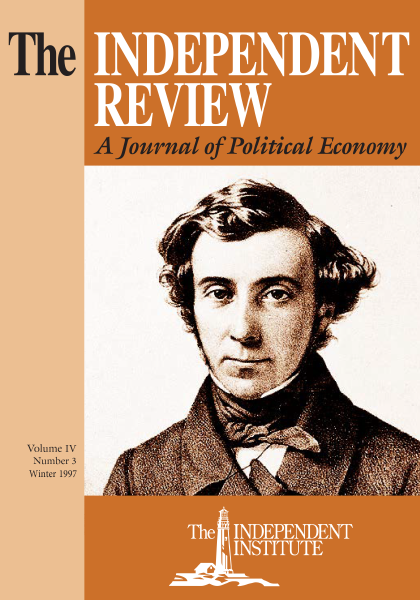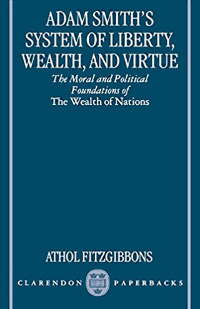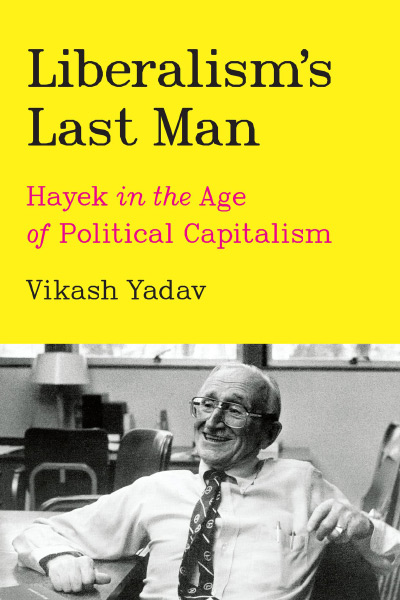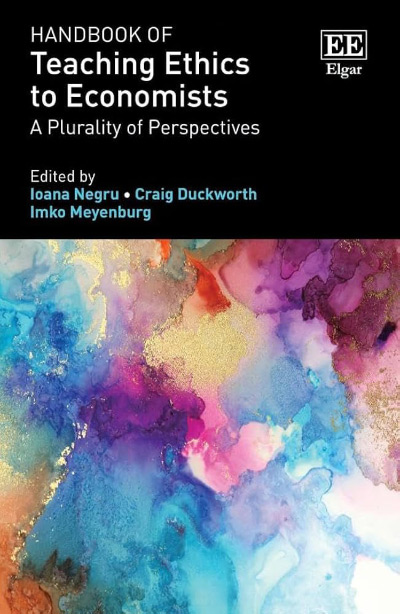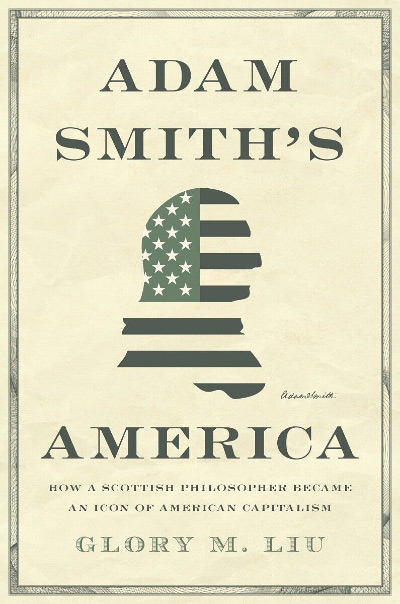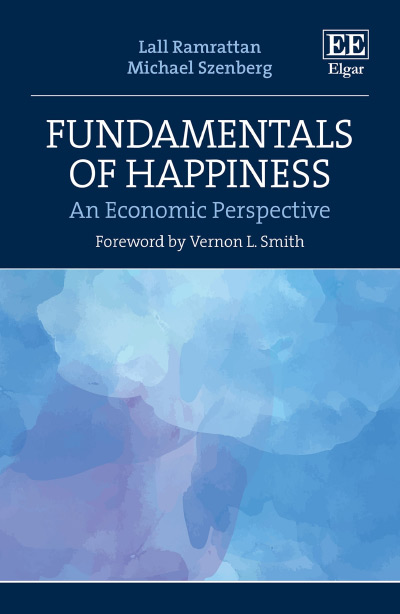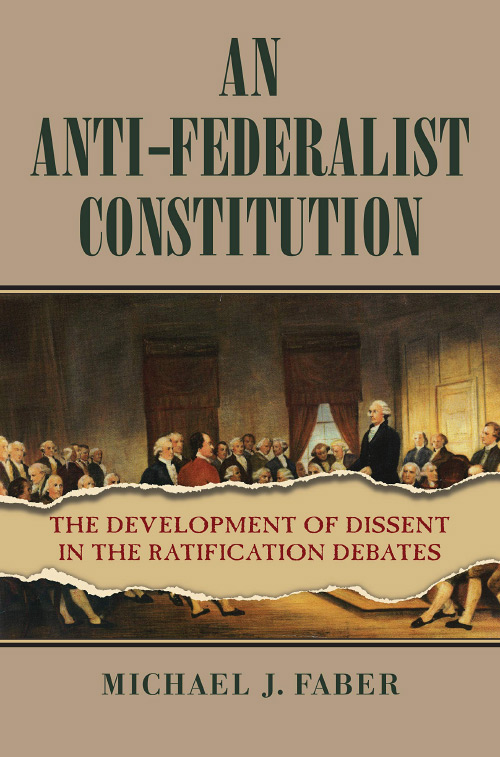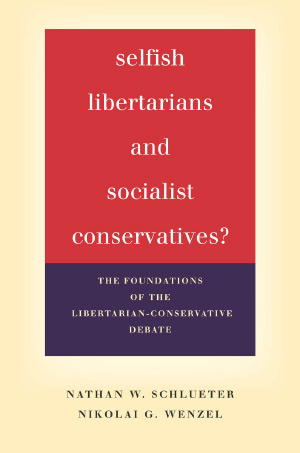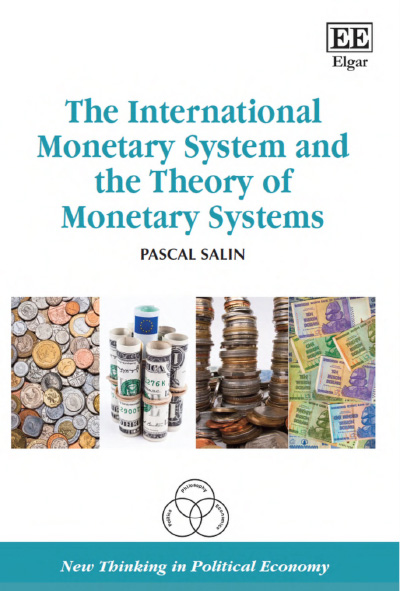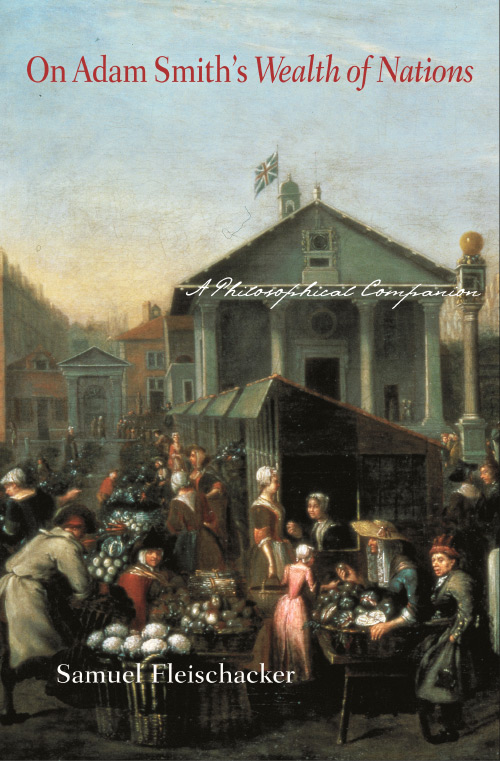This book is an attack on the view that Adam Smith conceived of the science of economics after shelving moral considerations and wholeheartedly approving of the motivating force of self-interest. This view, which the author claims to be widespread among Nobel-prize-winning economists, rests exclusively on a superficial reading of The Wealth of Nations (WN). Fitzgibbons argues that in Smith’s preceding book, The Theory of Moral Sentiments (MS), virtue, and not self-interest, was the most workable standard in life. Moreover, he did not place morals and economics in different compartments but strived to integrate them in one all-embracing philosophy. MS indicates that Smith intended his theory of morals to be the intellectual foundation of a total system that included politics, economics, and law. He wanted to supplement the free market with a public recognition of virtue. Ultimately his system described an economy operating within a framework of moral self-constraint.
But what was the basis of Smith’s moral theory? Fitzgibbons provides an overview. Smith dispensed with early Christian rationalism because it was preoccupied with preparing people not for this world but for the next. In addition, Smith, like Hume, wanted to replace the Aristotelian worldview with an outlook more consistent with the science of Sir Isaac Newton. Newtonian physics had replaced Aristotelian physics, and Smith belonged to the new group of thinkers who opposed Aristotle and the Greeks whenever their doctrines were inconsistent with “science.” But whereas Hume wanted to replace virtue and practical reason with utility, Smith insisted on a moral version of the liberal state. Ultimately he believed that it was possible to make higher and lower motives compatible, to the benefit of society, by discovering the relevant laws of nature (p. 16).
Whereas Hume rejected the past, Smith looked to it for inspiration. He rejected Christian virtue in favor of Cicero’s stoic version, which implied the practice of virtue in political and public life. But whereas Cicero was pre-occupied with a virtuous elite and a philosopher-king, Smith proceeded to offer a general scientific theory of virtue with wide application. A liberal system of laws then followed from Smith’s science of morals. Although Smith rejected unworldliness and the Christian worldview, he did not promote materialism and self-love rather than virtue. “Smith was neither an idealist...nor a materialist...but a Stoic philosopher who wanted virtue to be relevant to this life rather than the next” (p. 19).
Smith’s moral theory led to a theory of jurisprudence that implied a cultural code and a political constitution. Political states that excluded either liberty or sound values thereby violated the laws of nature and hence were ultimately doomed. Fitzgibbons concludes that Smith’s economic theory was subsumed under his jurisprudence. For Smith, this was not a positive science of actual laws but a study of the principles that must inform the law if moral impartiality were to be respected. It was meant to replace the supreme judgment of the Greek philosopher-kings with the scientific predictability of the law. To elicit it, one must consult with Smith’s impartial spectator.
Fitzgibbons makes much of the differences between Smith and Hume, pointing out that the latter rejected the impartial spectator. He also notes that although Hume thought property was an arbitrary convention, Smith believed that a valid title to property required a moral foundation.
Regarding the moral principles Smith wanted to inject into commercial society, Fitzgibbons does not emphasize sufficiently that Smith considered prudence, as well as justice and beneficence, to be one of the virtues. Because it is prudent to buy in the cheapest market and to sell in the dearest, it would seem that Smith and Hume converged. Fitzgibbons stresses, however, that for Smith prudence was not enough. There was the additional need “to encourage participation in civic life” (p. 103). This suggests, of course, the concept of “civic humanism” sometimes attributed to Smith. It is difficult, however, to find in Smith’s writings explicit encouragement to the working population to attend public meetings, participate in voting, witness council chamber proceedings, and so on. Certainly Smith speaks in terms of “good citizenship,” but this can be practiced in one’s workplace and neighborhood. Because Smith, following the Stoics, regarded the individual as a “citizen of the world,” he concluded that the best available way to help fellow individuals globally is by participating in the free market, an institution that alone has the virtue of ensuring that the unknown and unimportant have their wants served along with those of others.
It seems predictable that many economists will see this book as a case of the philosophy tail wagging the economics dog. Granted that much moral philosophy attaches to Smith’s economics, and despite Fitzgibbons’s contention that “there was no ‘modern economist’ inside Adam Smith trying to get out” (p. 171), WN contains many indications of the development of economic thinking for its own sake. New-found foreshadowing of late-twentieth-century economics in Smith’s WN now includes the modern principle-agent problem; the monetary approach to the balance of payments (which Fitzgibbons appears to have missed); credit rationing; theories of screening and sorting; the theory of rent seeking; the theory of organization; human capital theory; and the theories of nonprofit enterprise, public goods, public choice, and nonmarket behavior in general.
Fitzgibbons speaks with less authority on economics than on philosophy. He argues that Hume, not Smith, founded the neoclassical school of economics and that this school, later developed by writers such as Sir John Hicks and Paul A. Samuelson in the mid-twentieth century, “presented general mathematical accounts of the economy that were built by summing individual utility functions, and all of whom have included an account of economic change over time” (p. 191; my emphasis). The implication is that Smith suffers by comparison. But the boot is on the other foot. Smith did include an account of economic change over time, whereas those of the neoclassical writers mentioned were unsatisfactory. Their mathematical constructs, which so impress Fitzgibbons, need the constant-returns-to-scale assumption to permit the derivation of formal existence proofs. Yet The Wealth of Nations generally denies constant returns and contains fundamental obstacles to all these attempted general-equilibrium models. The central challenge occurs in chapter 3 of WN, “That the Division of Labour Is Limited by the Extent of the Market.” What is a market? Surely it is the ability and willingness of individuals to purchase, a function of produce offered in exchange. Smith’s pin factory example was one of increasing, not constant, returns; the large volume of pins produced after specialization created a demand for other things in exchange. In the words of a famous article on Adam Smith’s system by Allyn Young (“Increasing Returns and Economic Progress,” Economic Journal 38 [December 1928]: 527–42), “The counterforces which are continually defeating the forces which make for equilibrium are more persuasive and more deeply rooted in the constitution of the modern economic system than we common realize.” And Young’s interpretation is the one currently gaining ground. (See J. M. Buchanan and Yong J. Yoon, The Return to Increasing Returns. Ann Arbor: University of Michigan Press, 1994.) That the dynamic account of economic change in WN cannot be easily handled by neoclassical mathematical economists reflects badly on them rather than on Smith.
The only question that remains is whether the derivation of Smith’s vision of dynamic economic change via his theory of increasing returns was also connected primarily with his moral philosophizing. I have my doubts.

